Menu
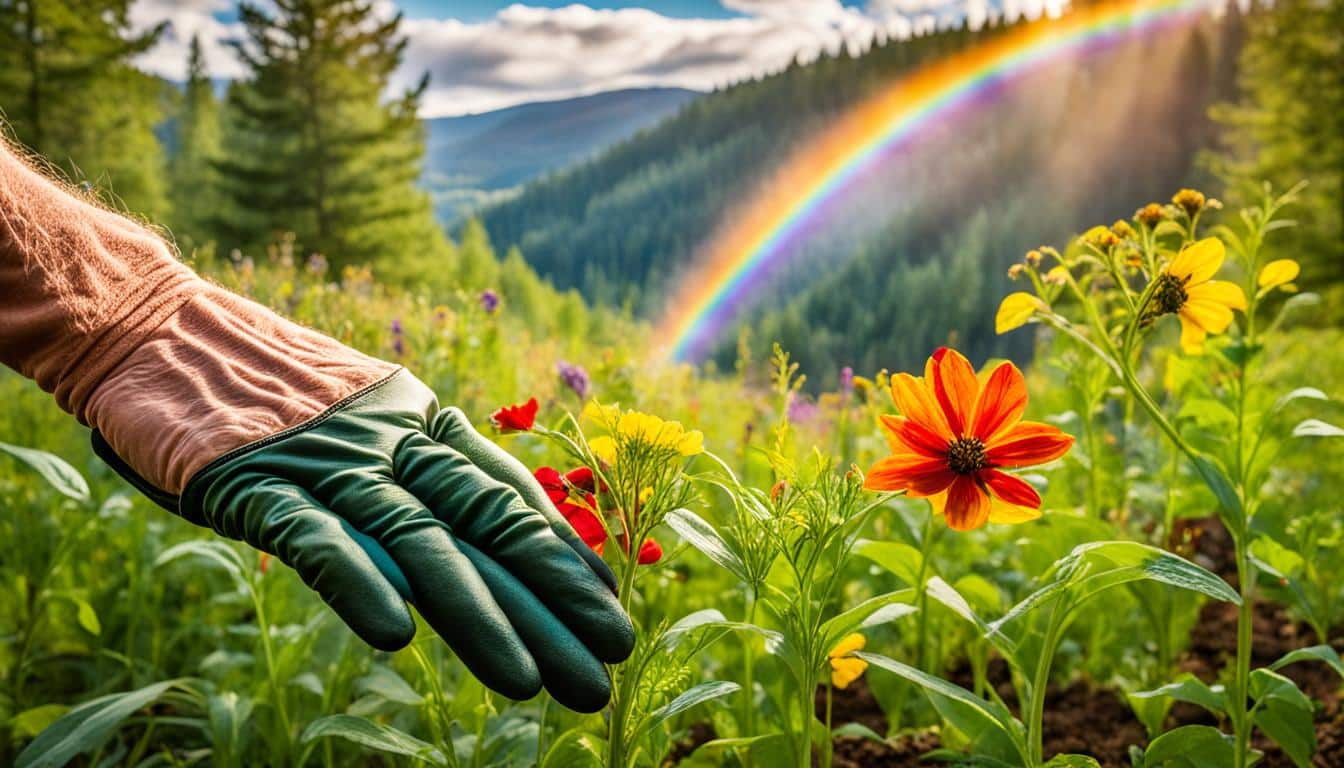
The earth smells freshly tilled beneath my feet, a sign of our close bond with the land. Featuring at the intersection of nature and human effort, it’s clear how vital saving agricultural biodiversity is. It isn’t just about the environment. It’s about securing a future for those to come. One-third of our land is crafted by agriculture, changing our world as we know it.
I live in a place known as one of the world’s 25 biodiversity ‘hot spots’, with over 1.1 billion people depending on agriculture. Here, beauty and challenges walk hand in hand. We see everything from vast grazing fields to a small amount of food growing in forests. Our land’s use is both varied and necessary. But, cutting down forests, using too many pesticides, and pollution are big problems we face.
Did you know that we humans now make more nitrogen than nature itself? This shows us why it’s crucial to farm and protect habitats in a smart way. With the need for farming products increasing 50% in the next two decades, we must turn to eco-friendly agriculture. This approach combines farming with saving nature. It makes sure we can keep using our land well, sustain our farms, and protect nature for years to come.
For our planet to thrive, it’s critical that we protect biodiversity in farming. This helps keep our ecosystems healthy and balanced. Farms with a rich variety of life are better able to withstand challenges from nature. They also tend to produce food for longer periods.
Biodiversity is key for the good working of natural processes. For example, different plants help pollinators, control pests, and make soil fertile. These actions make farming more natural and less reliant on chemicals.
Having many types of plants and animals makes our food stronger against diseases and pests. It also helps the land to recover after facing problems, which is really important for keeping farms sustainable.
Diverse fields and farms provide us with many important services. They keep water clean, protect the soil, and look after places where pollinators live. Sadly, many pollinator species, like monarch butterflies, are in real danger because we are damaging their homes.
By using methods like planting different crops each year and turning waste into food for the soil, we can make fields better. This helps farms to stay healthy and protect our planet’s balance.
Looking after biodiversity means good things for farmers too. They need to use fewer chemicals when they have a variety of crops. This saves them money and makes their farms better at handling changes in the weather.
When the soil is healthy and bees and other pollinators are around, farmers can depend more on their crops. So, by helping nature, farmers help themselves and ensure we all have enough food.
| Aspect | Impact |
|---|---|
| Soil Fertility | Enhanced by diverse crops and composting |
| Pollination | Supported by robust pollinator habitats |
| Pest Control | Managed through natural biodiversity and reduced pesticide use |
| Cost Reduction | Lower dependence on synthetic inputs |
| Food Security | Ensured through diverse crop yields |
The modern agricultural setting faces many challenges. These challenges impact the land and its biodiversity. The need for more food has led to using a lot of land and resources. This has brought up many important issues.
About a third of lands globally are used for farming or pastures. This change takes up a lot of space, about 30%. It leads to significant changes in the environment and causes animals to lose their homes. An additional 10-20% of land is for livestock to graze. This harms natural habitats and puts many species at risk. What’s more, over 45% of protected areas worldwide are extensively farmed. This makes it hard to protect habitats.
Pesticides and fertilisers cause big pollution problems. They get into water and soil. Between 1890 and 1990, the amount of nitrogen from human activities increased a lot. This pollution damages soil and reduces the variety of plant and animal life that can live there. Also, farming uses around 70% of fresh water. This may run out or get too dirty to use, affecting farming in the future.
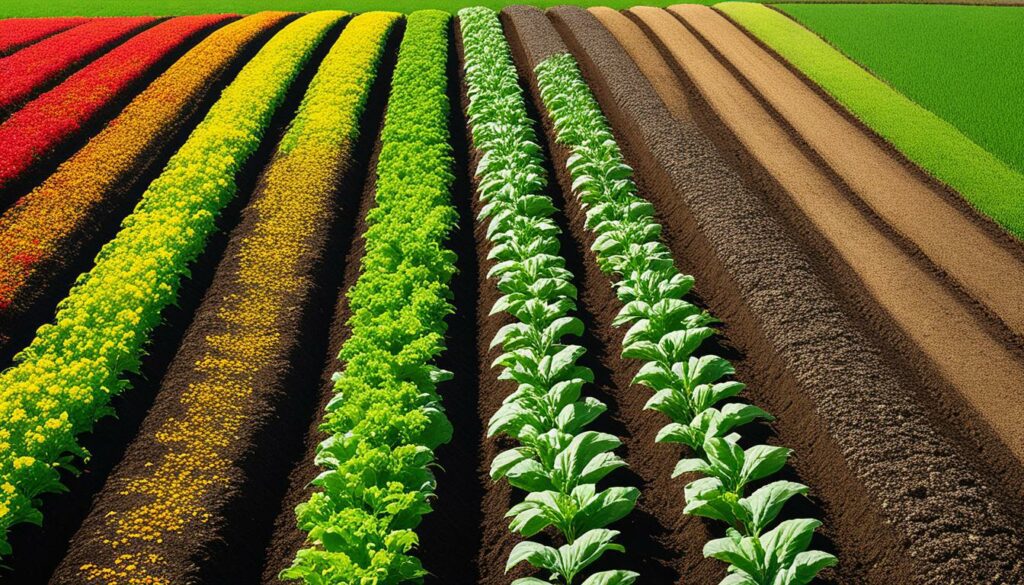
Climate change makes the problems in farming worse. It causes unpredictable weather. This hurts the amount of food we can grow and the wildlife around us. With the world’s population growing, we might need to farm more land. But this can hurt natural areas. So, it’s crucial to find ways to farm that help our planet. The changing climate means we have to work hard to protect both the land and water areas.
Ecoagriculture practices try to balance farming with saving plants and animals. It mixes caring for the environment with growing food. This way, both farming and nature can thrive. Over 30% of the world’s land is used for farming or growing food.
A big part of the land is used for animals and just a little for natural forests. About 90% of the world where we can live is shaped by what we do. Over a billion people who live in special nature spots need farming to survive.
Places like California have lost a lot of their wetlands. These changes affect the land, making it hard for some plants and animals to live. But, changing to safer ways of farming can help a lot.
The world will soon have more than 8 billion people. This means we will also need more food. But, the old ways of farming are not good for the planet. We must find new ways that do not harm our environment.
The future of farming will be about protecting nature while growing food. Biodiversity in farming means having many types of plants and animals. This makes farms strong and the land healthy.
For example, coffee farms in Central and South America are rich in different plants. The knowledge of Indigenous people, like the Tzeltal Mayans, also helps. Their wisdom can make farming better for nature and for us.
Being for sustainable farming, I value methods that work with our environment. They help keep the natural balance and boost our long-term harvests.
Organic farming is at the heart of green agriculture. It doesn’t use man-made chemicals, which is good for the land and the environment. We see a big rise in how well nature works for us – without less harvest.
Permaculture reaches for farming that takes care of itself. It uses nature’s ways to create a strong, lasting farm. Things work together better, and farms are healthier and fuller of life.
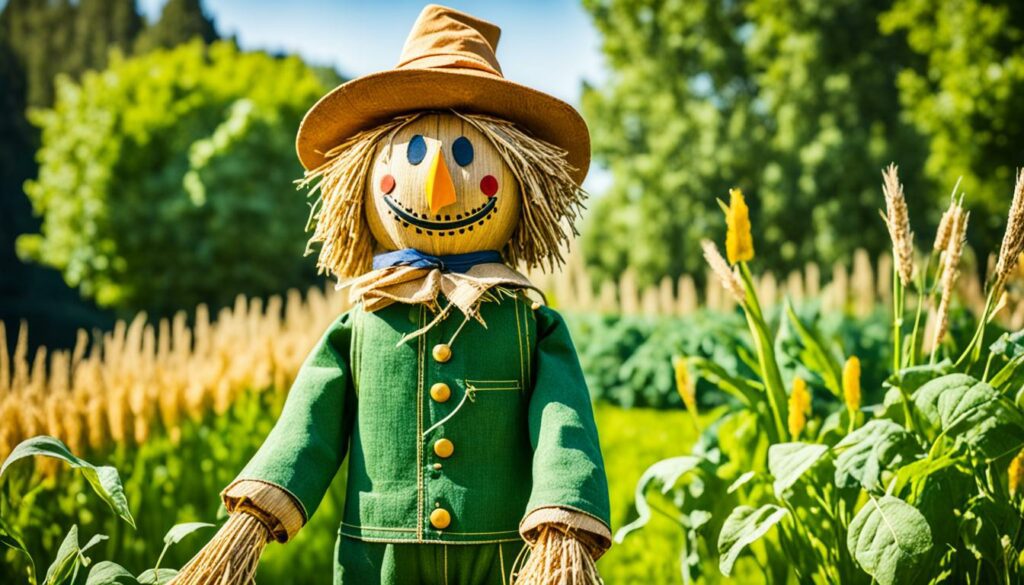
Agroforestry joins trees with crops, making good use of the land. It’s great for both wild animals and growing food. This mix boosts the land’s health and our crops.
Here’s a table to compare the strong points of these methods:
| Method | Key Benefits | Impact on Ecosystem Services |
|---|---|---|
| Organic Farming | Excludes synthetic inputs, enhances soil fertility, minimises environmental impact | Improved soil health, reduced pollution, better biodiversity |
| Permaculture | Creates self-sustaining ecosystems, mimics natural processes | Enhanced resilience, efficient resource use, increased species diversity |
| Agroforestry | Integrates trees into agricultural systems, optimises land use | Improved pollination, better soil health, diverse crop habitats |
Taking up these agroecology ways is key for a farming method that lasts. It boosts our fields, keeps nature healthy, and helps farmers in the long run.
Biodiversity-friendly farming is key to sustainable agriculture. It aims to keep ecosystems healthy and create productive landscapes. By using a variety of methods, we can ensure farms help many different plants and animals.
Cover crops and crop rotation are vital for the soil and fighting pests. Cover crops stop erosion, add to the soil, and make it better. Rotating crops helps soil stay fertile and stops too many pests from growing.
| Practice | Benefits | Evidence |
|---|---|---|
| Cover Crops | Reduces soil erosion, improves soil structure | 35 identified practices, 2538 data records |
| Crop Rotation | Enhances soil fertility, breaks pest cycles | 331 studies reviewed, positive biodiversity impact |
Conservation tillage keeps the soil mostly undisturbed. This helps the soil keep its structure and organic matter. It supports soil life like earthworms and good microbes, making nutrients more available. By using this method, farmers can slow down soil erosion and runoff.
Biodiversity-friendly practices like contour farming and terracing have a good effect on biodiversity. Crop diversity also plays a big part in helping different plants and animals thrive.
Integrated Pest Management (IPM) is a smart way to deal with pests without using too many pesticides. It uses natural means to control pests, helping good species to thrive. IPM improves the health of the whole ecosystem, lessening the harm from chemicals. Many studies show that avoiding pesticides is very good for the land and its creatures.
To sum up, using these farming methods can make our ecosystems much healthier. These ways of farming help the land and its creatures to thrive, leading to a more lasting and diverse farming world.
Keeping a wide range of genes in crops is crucial for food security and tackling climate change. This effort ensures that crops can fight off pests, diseases, and other threats well.
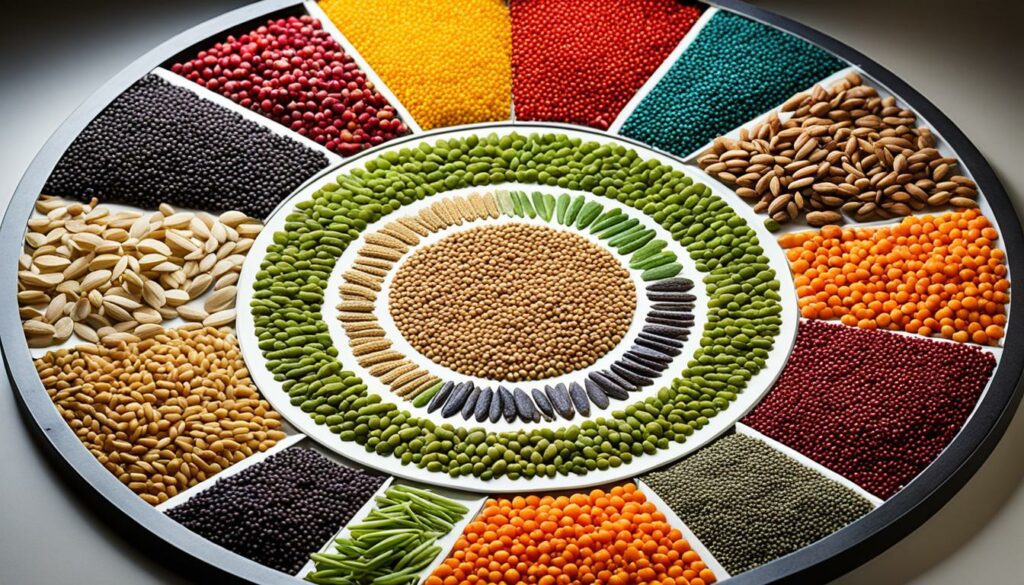
Seed banks and centres for preserving crops are key. They store seeds of different plants, including heirloom varieties. This maintains a rich gene pool for battling climate changes and diseases.
A recent study in 2021 highlighted that work in seed banks is helping keep vital crop genes safe.
Heirloom crops, with their special traits and local history, are very important. They offer many advantages, such as better resistance and nutrition. These old varieties connect our farming past with present needs, supporting breeding efforts. In a major review in 2010, experts stressed the need to safeguard these heirloom plants against the impacts of modern breeding methods.
| Study Year | Key Findings |
|---|---|
| 1983 | Appraisal of genetic diversity and vulnerability |
| 2014 | Challenges in conserving and utilizing plant genetic resources |
| 2015 | Climate variation explained a third of global crop yield variability |
| 2017 | Biological annihilation via sixth mass extinction signaled by vertebrate population losses and declines |
| 2021 | Current scenario and future prospects of plant genetic resources and breeding |
The work to save and grow crop genes is vital for a green, lasting farming future. The use of seed banks and heirloom crops promises strength in crops and better genetic study.
Policies are key to promoting biodiversity conservation worldwide. They help align our actions with the goal of preserving diverse ecosystems. Whether through global, national, or local strategies, policies lead the way in protecting our environment.
The Convention on Biological Diversity is an example of such a global commitment. It sets standards for nations to work together in saving our natural world. Agreements like these make sure everyone does their part in protecting the Earth. Measures like the RSPO certification show how agriculture can help rather than harm, guiding us towards sustainable practices.
“Agriculture sustains one-third of the global population.”
In each country, these international goals are put into action through national plans. The Zero Deforestation Agreement in Honduras is a big leap in protecting our forests and the life they hold. These plans target local environmental issues, making them very effective in saving our planet.
| Country | Policy | Impact |
|---|---|---|
| Honduras | Zero Deforestation Agreement | Reduced habitat loss |
| Guatemala | RSPO Certification Partnership | Enhanced biodiversity in palm oil plantations |
It’s not just about national and international policies. Local efforts are crucial for real and lasting change. Getting communities involved makes sure these strategies work on the ground. In places like Nicaragua and Honduras, projects like cacao farming have not only increased profits but also helped protect natural habitats. There, as elsewhere in Central America, teams using advanced tools, like remote cameras, help track wildlife, contributing important scientific information.
When we combine efforts—from international goals to local hands-on projects—we form a strong web of support for our planet. Working together at all levels makes it possible to keep our environment healthy for both us and the many living things we share it with.
It’s key to understand if saving nature makes financial sense. Farmers and leaders need to see the benefits. Looking at the money and environmental gains, we need to do detailed checks. So, we make smart choices.

Analysing the costs and benefits of saving biodiversity is vital. When farming takes over, 80-90% of natural areas change. Investing in nature can bring big profits, too. For example, losing pollinators might cost farming US$ 217 billion every year.
To save nature, we need lots of money. In 2019, between US$ 124 and US$ 143 billion was put towards this globally. But, we need US$ 711 billion more every year. We could cover a big part of that by using the US$ 542 billion spent on bad farm support in better ways. Also, we could get an extra US$ 169 to 416 billion each year for nature.
Governments are key to making sure everyone helps save nature. They can encourage farmers to use greener ways by funding them. To cover the full cost isn’t too much compared to the whole world’s money. Just one percent of global GDP, or US$ 711 billion, could do it. This would help over 1.1 billion people in important nature areas.
| Aspect | Current Status | Future Potential |
|---|---|---|
| Financial Flows into Conservation (2019) | US$ 124-143 billion | Close biodiversity financing gap: US$ 711 billion annually |
| Harmful Agricultural Subsidies | Nearly US$ 542 billion/year | Redirect towards sustainable practices |
| Potential Revenue from New Mechanisms | US$ 169-416 billion annually | Estimated increase by 2030: US$ 280-287 billion/year |
| Impact on Pollinators | Loss could lead to US$ 217 billion annual drop in agricultural output |
Keeping a variety in agriculture is key to healthy ecosystems and high productivity. By caring for the soil, saving water, and helping out beneficial animals, we keep the balance. This makes our farms more resilient and the earth healthier.
Soil health is essential for keeping farming diverse. Using methods like minimal tillage and adding organic stuff improves the dirt. This helps the soil hold together better. Also, it boosts the life underground that helps plants grow.
Looking after water is very important, too. Smart watering systems, such as drip feeds, save water and stop it being wasted. Collecting rainwater means we have more water to use without harm. These ways help our farms and nature around them stay well.
We need to make homes for good insects and animals, like pollinators and pest eaters. By protecting wetlands, along rivers, and bits of forest on farms, we help many different creatures. This keeps things in balance and our nature rich.
Putting these top ideas into action makes farming better for the planet. With a big part of the world’s land used for farming, and most of it affected by people, these steps are crucial. It is teamwork to make sure farming stays productive yet mindful of nature. This way, we secure a good future for both farming and the rich life it depends on.
Agrobiodiversity protection is crucial for our farms and the environment’s health. Key strategies include using buffer zones, polyculture, and controlling invasive species. I will explain more about these methods and why they are important.
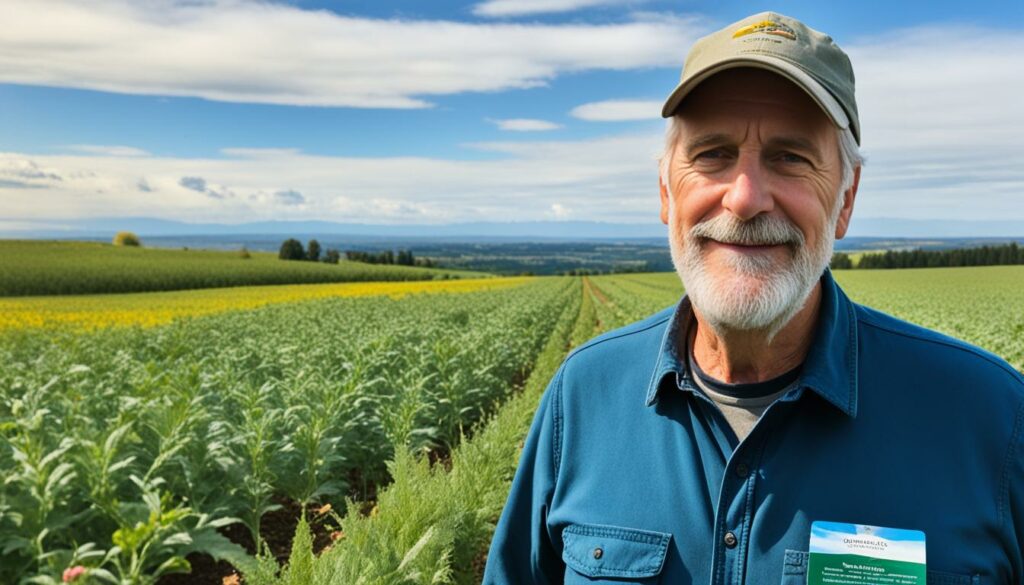
Buffer zones are vital in protecting agrobiodiversity. These areas around farms help safeguard water sources and prevent the spread of farm chemicals. When farmers plant perennial crops in these zones, it reduces the need for nitrogen. This, in turn, helps lessen water pollution and supports more living things in the water.
So, creating buffer zones isn’t just about conserving nature. It also makes our farms stronger and more sustainable.
Polyculture is important for healthy ecosystems. By growing different crops together, we make our farms more like natural ecosystems. This boosts the variety of plants and animals and keeps crop growth steady.
Growing many crop types together also helps fight pests and keeps the soil healthy. It’s a major part of good, sustainable farming.
Controlling invasive species is a big part of protecting agrobiodiversity. Invasive plants and animals can harm local species and make the ecosystem less diverse. This hurts farm production. To fight them, we should care for local plants, watch the chemicals we use, and manage pests in a smart way.
By doing this, we can keep our local species and natural areas safe, which is key for healthy farms.
Using buffer zones, planting different crops, and fighting invaders all help protect agrobiodiversity. This makes our farms more resilient and lasting.
Crop diversity management is key to making farming more sustainable. A wide variety of crops helps farms be more resilient. This means they can rely less on chemicals and fight off pests and diseases better.
It’s crucial to have many different types of crops on farms. This diversity makes crops tougher against changing conditions. Mixing crop species leads to better farming overall, making it more productive and balanced with nature.
Growing a mix of crops helps fight off diseases and pests. Each crop variety brings its own protection, reducing the need for chemicals. This approach also helps keep healthy the insects and microorganisms that benefit farming.
Local crops play a big role in food sovereignty. They’re used to local conditions and are often stronger against diseases and pests. Buying local supports biodiversity and saves traditional farming practices. This is crucial for facing future food challenges.
Using diverse crops is key as our world needs more food. Farms that mix crops and use local varieties produce more without harming the land. This ensures our food supply can last a long time.
Conventional agricultural practices have changed the environment in big ways. They’ve turned vast areas into fields for single crops. This change is often seen in the production of biofuels. The United States, for example, has turned millions of acres into corn fields, causing a fall in diversity.
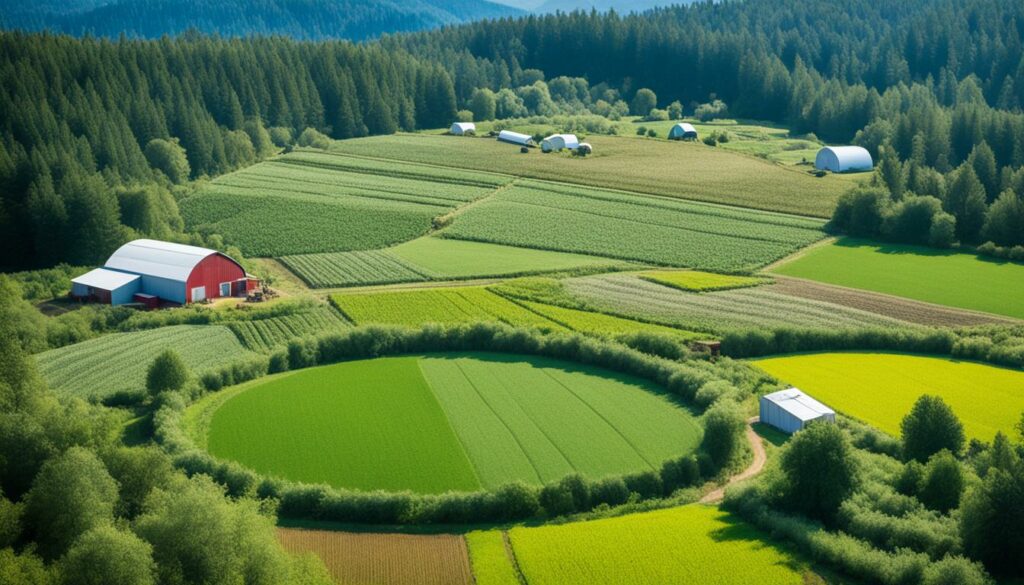
Studies show that the variety of plant and animal life in an area are vital. They help keep ecosystems working well. Biodiversity does things like help plants grow, keep pests in check, and make the soil healthy. But, the use of chemicals in farming can harm this balance. Chemicals often end up in water and hurt the land.
To tackle these problems, we need to farm in a way that keeps the wild spaces alive. Changing to farming methods that work with nature can protect species and their homes. This method values wildlife and plants as essential parts of a farm. They are not an addition, but key for a farm to be successful.
Take Canada, for example. Only a small part of its land is good for farming. Yet, more than half of the wetlands in its south have been drained. This was mainly to grow crops. It shows why we must farm in ways that keep our wild areas safe. We need to stop hurting biodiversity and help the land stay healthy for the future.
Looking into biodiversity conservation across the globe teaches us a lot. We see various methods and encounter both the positive results and the difficulties faced. These examples highlight how beneficial and tough farming for biodiversity can be everywhere.
In Europe, traditional farm landscapes play a key role in keeping biodiversity. Around one-third of its land is for growing crops and pastures. These areas work hard to produce food while protecting the environment. They use different farming techniques like changing which crops are grown each season and not disturbing the soil much when planting. Over the years, these methods have helped keep the land rich in plants and animals. This is because farmers there have used these lands for a very long time.
Africa shows us how much difference local people can make in protecting nature. In places where many people and a lot of unique plants and animals live, the community is key. For instance, new ways of farming in Africa have let locals grow more cereals without harming the environment. These efforts help not just in saving nature but also in making sure there’s enough food and jobs for everyone. Projects led by the locals focus on ways that are good for nature and people at the same time.
North America is not trailing behind in the race to protect nature. It’s using smart ways to farm that help the land and many animals to survive. One good example is no-till farming, a method that keeps the soil from washing away and still supports many kinds of life. This kind of farming is good for the land and for the creatures that live around. With more people wanting to eat meat, these new farm methods can show the way to do it without hurting the planet. They set an example for farmers everywhere on how to look after the land well.
These stories about farming wisely are a hope for the future all around the world. Studying these cases inspires us to use new ideas and to let local people lead the way in caring for nature. This is the key to keeping our earth healthy and full of life.
The future of saving agricultural biodiversity depends on new trends and technologies. We’re getting closer to a world with 9 billion people, which means we need between 70 and 100% more food. This info comes from the United Nations and the Food and Agricultural Organization. Mixing conservation methods with the latest tech is essential to meet this demand.
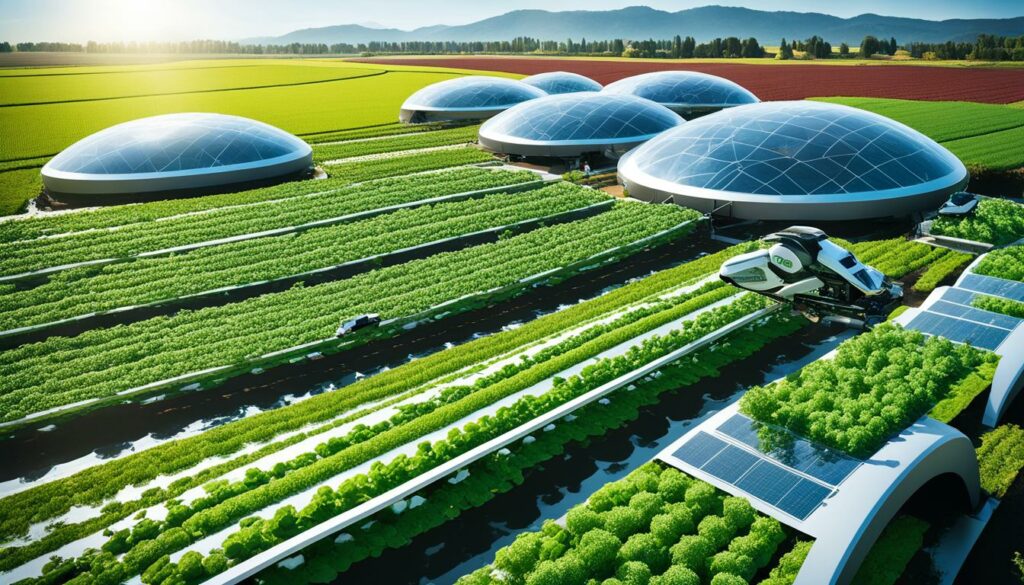
Today, saving the planet relies on natural solutions. In the Netherlands, these methods improved water quality by 34%, raised agriculture’s sustainability by 24%, and upped biodiversity protection by 22%. At the same time, new farming technologies like precision agriculture and going organic are helping. They make protecting biodiversity more effective.
Studies in sustainable farming have found ways to help nature and the environment thrive. Agroforestry, for example, shows high diversity and stability. This supports the health of the ecosystem over time. Moreover, the variety of soil creatures is lower in normal farming methods. Keeping up with research and development helps keep these benefits coming.
Conservation efforts in farming are proving to be very positive. For instance, letting more plants grow around vineyards helps many animals, from birds to insects. It proves organic farming is great for wildlife, increasing the presence of insects, which is good for the whole ecosystem.
Every person’s part in saving biodiversity is crucial. Our choices affect the health of our planet. Whether it’s what we buy or how we help protect nature, everyone can do something.
Choosing biodiversity-friendly products is easy and impactful. Opt for items with eco-friendly labels like FSC or Rainforest Alliance. This supports good practices for nature. Remember, buying from local farms helps, too. They care for different crops and lessen damage to the environment.
Getting involved in local conservation is key. Planting local flowers or helping local plant growers boosts your area’s natural variety. Saving local plants and animals helps the whole ecosystem stay strong. Also, it’s important to respect natural areas. People can sometimes harm these places, putting local nature at risk.
Teaching others about biodiversity is vital. Learning and spreading the word on biodiversity’s importance and your role in it helps. Little acts like saving water and getting others to join you keep nature healthy. Together, our small steps do big things for the earth we share.
At the end of the day, each person’s part in saving nature matters a lot. Every wise choice gets us nearer to a planet thriving with life.
Agricultural technology is changing the way we farm. It brings chances to make our world more diverse. Innovations like precision agriculture tools and data-driven farming help farmers work in a way that is good for the land. They keep our planet’s many ecosystems healthy.
Agriculture is getting smarter thanks to tools like drones and AUVs. These gather a lot of data about plants and animals in hard-to-reach places. Robotic pollinators act like bees, helping plants to grow strong and diverse.
Data is at the heart of today’s farming. By using detailed analytics, we can make choices that protect nature. For example, in invasive species control, robots help without causing harm to local plants or animals. They also aid in fixing damaged habitats, making the recovery of ecosystems quicker.
Remote sensing in conservation uses technology to watch over nature. With help from satellites and UAVs, we can keep an eye on vast areas without bothering local life. UAVs are key in studying plants, testing soil, and finding animals in different places. These efforts help us learn and protect a wide range of species.
| Technology Type | Main Function |
|---|---|
| Drones/UAVs | Data collection over vast terrains |
| AUVs | Underwater species and habitat monitoring |
| Robotic Pollinators | Assisting in plant pollination |
| Automated Weeders/Planters | Invasive species control and planting |
New tech is making it easier to farm in ways that are good for the earth and its creatures. This mix of innovation and nature is vital for boosting biodiversity. It helps farming to be a friend, not a foe, to our planet.
Conserving agricultural biodiversity is vital to keep nature in balance and our food supplies sustainable. But, currently, 9 out of more than 6000 plant types supply 66% of the world’s food. This shows a big gap and calls for better strategies to protect our farm species.
Moving to more sustainable farming means protecting a variety of living things. To do this, certain targets, like Aichi’s 3, 4, 7, 8, 13, 14, and 18 are very key. Recognising how farming and nature connect leads us to create eco-friendly ways to farm and keep the ecosystem balanced.
More than 1.1 billion people who rely mainly on farming live in spots rich in different life forms. But, farming often harms their homes, through cutting down forests and spraying too many chemicals. This has led to too much nitrogen in the soil and water, which isn’t good for them.
Choosing to save different farm species can also bring in a lot of money, possibly $5.7 trillion a year by 2030. The key is to farm in a way that supports many different life forms. This includes protecting bees, using microbes to fight pests, and keeping the soil and seeds diverse.
| Statistic | Impact |
|---|---|
| Global Land for Food Production | Nearly one third |
| Key Plant Species for Crop Production | 9 species account for 66% production |
| Economic Gains by 2030 | $5.7 trillion annually |
| People in Biodiversity Hotspots | Over 1.1 billion |
| Freshwater Dedicated to Agriculture | 70% |
As farming areas grow, animals and plants get pushed out or lose their homes. But, with more than 8 billion people expected by 2030, farms will also need to grow. So, using farming ways that don’t hurt the environment is key to saving our planet’s many life forms.
The need to protect agricultural biodiversity is critical. It is key to ensuring agriculture can last, help nature recover, and use biodiversity wisely. Our farming history dates back about 10,000 years to places like Mesopotamia and China. We must work hard to keep up this tradition through careful biodiversity management.
Our actions have sped up the loss of species, making them disappear 1,000 times faster than normal. Over 190 countries agree to stop biodiversity loss. This agreement, called the Convention on Biological Diversity, focuses on using nature wisely and fairly. Biodiversity is key for farming, as it helps with healthy soil and water.
Farming is losing its variety because we are growing in numbers and using a lot of resources. We must change how we farm to protect biodiversity better. This is very important because most of the world’s poor live in the countryside. They need our help to farm sustainably. Improving how we use different plants and animals in farming can help us reach important global goals. Tools like Simpson’s and Shannon’s indexes can guide our actions. Governments and policies must support these changes to protect our planet.
Agricultural biodiversity conservation is about protecting a variety of plants and animals. Farming methods focus on keeping the environment healthy and promoting long-term farming. This way, we can protect nature and feed people sustainably.
Biodiversity is vital for healthy soil, keeping pests under control, and helping plants reproduce. It makes farms stronger, able to handle tough weather without needing harmful chemicals.
Farms face big problems like cutting down trees and losing natural homes for animals. Pollution from farm chemicals and the changing climate are also huge challenges. These issues put farm life and the environment at risk.
Ecoagriculture combines farming with protecting nature. It creates farm landscapes that help the environment and produce food. This is important for our planet’s health and our food needs for the future.
Agroecology includes ways of farming that work with nature. This means using few chemicals, growing various plants together, and also planting trees among crops. Such methods help nature and farm life thrive together.
Farming techniques focus on keeping soils healthy by growing specific plants at times. They also help reduce pests without using a lot of chemicals. Even how we dig the soil can make a big difference by not hurting it too much.
Seed banks save many types of plant seeds for later use. They help keep plant variety safe from climate changes and diseases. This way, our food sources stay strong and diverse for the future.
Rules at different levels, like local and global, set the stage for protecting nature. Big agreements aim to keep the Earth’s life rich. Local actions and public events also help a lot in saving nature around us.
We look at both the costs and the benefits of saving nature on farms. Government money and help from non-profit groups are also very important. They make it easier for farms to take good care of the environment.
Growing plants in ways that keep the land and water clean and safe is key. These methods also help animals and insects find a home on the farm. Supporting local wildlife by planting special areas is another great way.
Creating safe areas around farms and growing many different plants together are main steps. This keeps the land working well and helps nature survive. It’s all about farming like nature does.
Growing many different types of plants helps farms cope with bad weather and pests. This makes farms more stable without needing a lot of chemicals. It’s a smart and natural approach to farming.
Old farming ways often harm nature. To keep the land alive and well, farms need to use methods that help and not hurt the environment. This way, wild plants and animals have a better chance to live.
Good examples are found in keeping old farm landscapes in Europe, and in community work in Africa. New methods in places like North America show that farming can be good for both people and nature. These stories inspire us to do more for our planet.
New technologies and smarter ways to farm are on the rise. They are helping us protect nature while farming. With better tools and knowledge, we can make sure that our farms are a safe place for all living things.
Choosing food that’s good for the planet, joining local nature projects, and telling others why nature matters can make a big difference. Everyone’s actions count in saving our natural world.
Tools that help farmers know more about their land and plants are becoming more common. By using information to farm smarter, we can grow food and protect nature. This is the power of technology for a greener future.